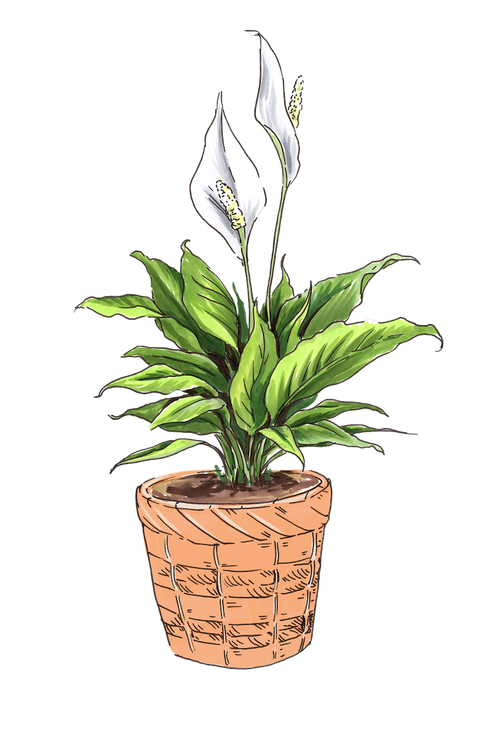Peace Lily Care Guide

-
Light : Medium
Best in medium light, but can survive in a range of low to high.
-
Water : Medium
Allow the soil to dry out completely between waterings.
-
Humidity : Medium
Prefers humidity. Spritz occasionally.
-
Temp : 65℉ - 80℉
Keep this plant out of cold drafts near open windows or doors.
-
Zone : 10|11
Outside: Keep them in full shade on a patio out of direct sunlight to prevent leaf burn.
-
Fertilizer : Seasonally
Peace lilies are not heavy feeders therefore, every six weeks is sufficient for their nutrient needs. Add a balanced liquid fertilizer to your water and dilute it by half. Fertilize throughout the late winter, early spring and summer months. Note: If your peace lily is not blooming, move them to a brighter area in the house to get indirect sun.
-
Repotting : 2 Years
When receiving the plant, do not repot immediately but wait at least 6-12 months or if the roots are beginning to get crowded and growing through the drainage holes.
Repot in the spring, using a 2"" bigger pot to keep the roots drier. (Too big of a pot could cause the soil to dry slower, which is not helpful.) Use a well-draining indoor potting mix with perlite to help with drainage.
Water your plant in the old pot before transferring over and let sit an hour. Place a piece of screening at the bottom of the container over the drainage hole to secure the soil and allow to drain. Add soil to the bottom to elevate the root ball. Lift the plant and release the roots against the existing planter. Use a clean knife or garden trowel to wedge between the pot and the soil to loosen.
Inspect the root ball. Notice if there are any dead or rotting roots and trim off with sterile pruners. If the plant is rootbound, cut through the roots to alleviate continued encircling.
Ensure the plant is sitting about 1"" below the edge of the pot to avoid water spillage. Add more soil and backfill around the sides by tamping down. Fill up to the soil line but not over.
Water thoroughly, leaving the soil damp but not soggy. If settling occurs, add more soil.
-
Cleaning : After bloom begins to die
Each time a flower blooms on the peace lily and turns brown, cut the stem off at the base. Prune off any yellowing leaves at the base of the stem. Clean any debris off the soil's surface. To clean, place the plant into a tub or shower. Use a watering can with a shower attachment using distilled, filtered, or water without chlorine or chemicals. Pour the water over the plant to wash away any dust. Do this each quarter to keep your plant's leaves clean.
-
Propagation : Division
Propagate and divide your Peace Lily plant in the early spring.
Hydrate the plant the night before.
Pull from the container and brush or wash away the soil carefully around the roots. Carefully divide and repot in rich, indoor peat-based potting soil mix, being aware that each new plant needs at least two or more leaves with sufficient roots attached.
Use a container 2 inches bigger than the root ball with drainage and deep enough for their roots to grow. Place the plant at the same level as the previous pot adding soil at the bottom.
Water the soil and add more soil if settling occurs.
Set them in medium to bright, indirect sunlight while they are rooting.
Check the moisture and humidity each day and add misting to keep the soil moist while the roots establish.
After 6-8 weeks, roots will begin to establish. You can tug onto the stem to ensure the roots are anchoring well.















